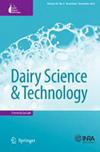Plasma and Colostrum Selenium Statuses of Properly Supplemented Belgian Blue Cows on Commercial Farms and Their Relationship with Sources of Dietary Selenium and Blood Biomarkers
Q2 Agricultural and Biological Sciences
引用次数: 0
Abstract
Selenium (Se) is an essential trace element for the health and immunity of cattle. Double-muscled Belgian Blue cows are well known to be prone to nutritional deficiencies. Colostrum Se level is also a key factor to promote immunoglobulin intake in young calves. The main objectives of this study were to assess (1) the plasma and colostrum Se statuses of properly supplemented Belgian Blue cows on commercial farms and (2) the relationship between Se concentrations in plasma and colostrum. The secondary objectives were to assess relationships between plasma or colostrum Se concentrations and dietary Se supplementation as well as blood biomarkers. Blood and colostrum samples were collected from 49 Belgian Blue cows on five commercial farms in Belgium. They received five different rations with Se supplementation ranging from 0.5 to 2 ppm, including 20% to 83% in organic form. Results showed that the average Se concentration was 90 ± 15 µg/L in plasma and 79 ± 26 µg/L in colostrum, consistent with previous studies on well-supplemented cows. No relationship was observed between Se concentrations in plasma and colostrum, suggesting that colostrum Se testing would be a complementary indicator for improving calf Se supplementation. Relationships between plasma or colostrum Se concentrations and dietary Se or blood biomarkers emphasized the complexity of Se metabolism in observational studies under field conditions.商品农场比利时蓝牛血浆和初乳硒状况及其与饲粮硒来源和血液生物标志物的关系
硒(Se)是牛健康和免疫必需的微量元素。众所周知,双肌肉比利时蓝牛容易营养不足。初乳硒水平也是促进犊牛免疫球蛋白摄入的关键因素。本研究的主要目的是评估(1)在商业农场适当补充比利时蓝牛的血浆和初乳硒状况(2)血浆和初乳硒浓度之间的关系。次要目的是评估血浆或初乳硒浓度与膳食硒补充以及血液生物标志物之间的关系。从比利时五个商业农场的49头比利时蓝牛身上采集了血液和初乳样本。他们接受了五种不同的硒补充口粮,硒补充量从0.5 ppm到2 ppm不等,其中有机硒补充量为20%到83%。结果表明,血浆硒平均浓度为90±15µg/L,初乳硒平均浓度为79±26µg/L,与前期研究结果一致。血浆硒浓度与初乳无相关性,提示初乳硒检测可作为提高犊牛硒补充水平的补充指标。血浆或初乳硒浓度与膳食硒或血液生物标志物之间的关系强调了野外条件下观察性研究中硒代谢的复杂性。
本文章由计算机程序翻译,如有差异,请以英文原文为准。
求助全文
约1分钟内获得全文
求助全文
来源期刊

Dairy Science & Technology
农林科学-食品科技
CiteScore
2.30
自引率
0.00%
发文量
0
审稿时长
2 months
期刊介绍:
Information not localized
 求助内容:
求助内容: 应助结果提醒方式:
应助结果提醒方式:


